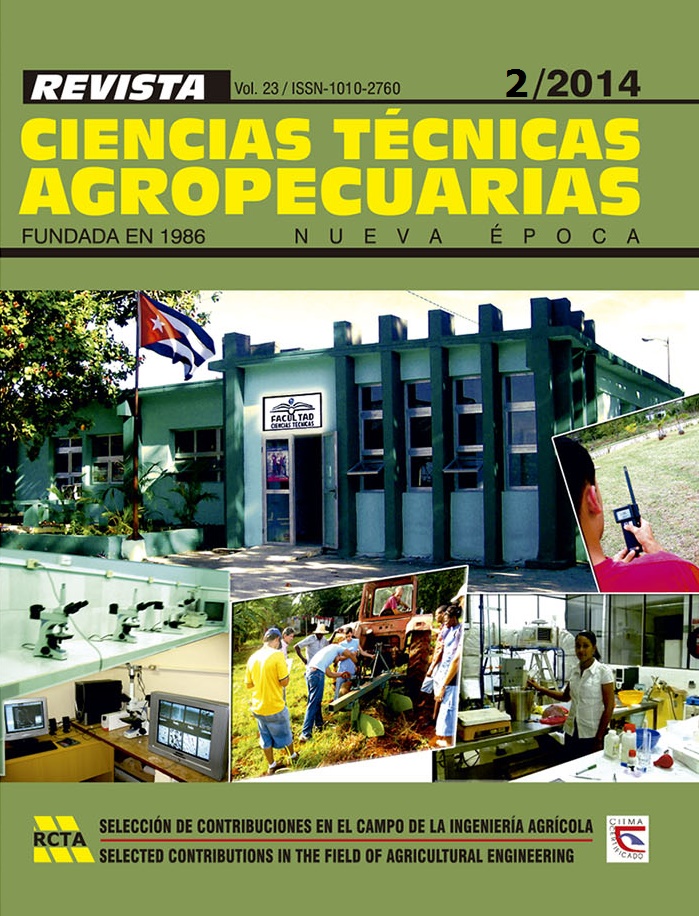Comparación de métodos para determinar capacidad de uso de tierras agrícolas, con fines de ordenamiento territorial rural, en Guatemala
Main Article Content
Abstract
estadísticas significativas entre la aplicación de una u otra metodología, respecto a la super ficie (cuantificada en ha) asignada a cada una de las unidades de capacidad de uso de las tierra, lo que con fines de implementación de programas de ordenamiento territorial rural puede afectar positiva o negativamente el manejo de los recursos naturales y la sostenibilidad de proyectos agropecuarios, recomendando discrecionalidad
en el uso de estas metodologías, de conformidad con el interés primario del programa de desarrollo a implementar.
Article Details
Those authors that have publications with this journal accept the following terms:
1. They will retain their copyright and guarantee the journal the right of first publication of their work, which will be simultaneously subject to the License Creative Commons Attribution-NonCommercial 4.0 International (CC BY-NC 4.0) that allows third parties to share the work whenever its author is indicated and its first publication this journal. Under this license the author will be free of:
• Share — copy and redistribute the material in any medium or format
• Adapt — remix, transform, and build upon the material
• The licensor cannot revoke these freedoms as long as you follow the license terms.
Under the following terms:
• Attribution — You must give appropriate credit, provide a link to the license, and indicate if changes were made. You may do so in any reasonable manner, but not in any way that suggests the licensor endorses you or your use.
• NonCommercial — You may not use the material for commercial purposes.
• No additional restrictions — You may not apply legal terms or technological measures that legally restrict others from doing anything the license permits.
2. The authors may adopt other non-exclusive license agreements to distribute the published version of the work (e.g., deposit it in an institutional telematics file or publish it in a monographic volume) whenever the initial publication is indicated in this journal.
3. The authors are allowed and recommended disseminating their work through the Internet (e.g. in institutional telematics archives or on their website) before and during the submission process, which can produce interesting exchanges and increase the citations of the published work. (See the Effect of open access).
References
AÑO, C.; J. SANCHEZ; C. ANTOLÍN: “Análisis y valoración de los sistemas de evaluación de suelos en España: evolución, tendencias actuales y perspectivas futuras”, Estudios Geográficos, 228: 331-353, 1997.
COOLS, N.; E. DE PAUW & J. DECKERS: “Towards an integration of conventional land evaluation methods and farmers’ soil suitability assessment: a case study in northwestern Syria. Agriculture”, Ecosystems and Environment, 95: 327–342, 2003.
DORAN, J.W.; T.B. PARKIN: “Quantitive indicators of soil quality: a minimum data set”, In: Doran, J.W.; Jones, A.J. (Eds.), Methods for Assessing Soil Quality, Soil Science Societ y of America, 49: 25–37, 1996.
FAO: Report on the Agro-ecological zones project, 158pp., Food and Agriculture Organization of the United Nations, World Soil Resources Report 48, Vol. 1: Methodology and results for Africa, Roma, Italy, 1978.
FERNANDES, L.A.; P.S. NASCIMENTO; S. D’ANGELO; C.A. DAYRELL & R. ARRUDA: “Relação entre o conhecimiento local, atributos químicos e físicos do solo e uso das terras”, R. Bras. Ci. Solo, 32: 1355-1365, 2008.
GUATEMALA, MAGA: Eds. Duro J. M., Monzón R.M., Vásquez Villatoro R., González Díaz G. R., García González G.P., Argueta Medina J.C., González Rivera O.R. Atlas Temático De La República De Guatemala. Guatemala: MAGA. Escala 1; 250,000. 127 p. Mapas a Colores.1 Disco Compacto, Guatemala, 2002.
GUATEMALA, MAGA-IGAC: Estudio semidetalado de los suelos y Capacidad de Uso de las Tierras del departamento de Chimaltenango, 968pp., Vol. I y II. Guatemala, 2010.
GUATEMALA, MAGA-IGAC: Estudio semidetallado de los suelos y Capacidad de uso de las Tierras del departamento de Sololá, 948pp., Vol. I y II. Guatemala, 2013.
GUATEMALA, INAB. 2000. Clasificación de tierras por capacidad de uso. Aplicación de una metodología para tierras de la república de Guatemala, 96pp., Instituto Nacional de Bosques, Guatemala, 2000.
KLINGEBIEL, A. & P.H. MONTGOMERY: Land capability classification, 21pp., USDA Agricultural Handbook 210, US Government Printing Office, Washington, D.C., USA, 1961.
LI N, L.I.: “A note on the concordance correlation coefficient”, Biometrics, 56: 324-325, 2000.
MAG-MIRENEM: Metodología Determinación Capacidad Uso Tierras Costa Rica, 30pp., Decreto No. 23214, San José, Costa Rica, 1994.
SÁNCHEZ, P.A.; W. COUTO, & S.W. BUOL: “The fertility capability soil lassification system: interpretation, applicability and modification”, Geoderma, 27 (4): 283-309, 1982.
SEVILLA, L. V. y J. COMERMA: “Caracterización de la Cuenca del Río Canoabo en el estado de Carabobo, Venezuela. II. Suelos y Tierras”, Agronomía Trop. 59 (2): 149-160, 2008.
SHENG, T.C.: Proyecto de clasificación de la capacidad de uso de la tierra orientado hacia su tratamiento, 13pp., proyecto PNUD/FAO, Kingston, Jamaica, 1976.
USA, AMERICAN SOCIETY OF FARM MANAGERS AND RURAL APPRAISERS: The appraisal of rural property, 525pp., Wisconsin University, Madison, USA, 2000.
USA, UNITED STATES BUREAU OF RECLAMATION: Irrigated land use, Part 2: Land classification. Bureau of Reclamation Manual, Vol. 5. U.S. Government Printing Office, Washington, D.C., USA, 1951.
